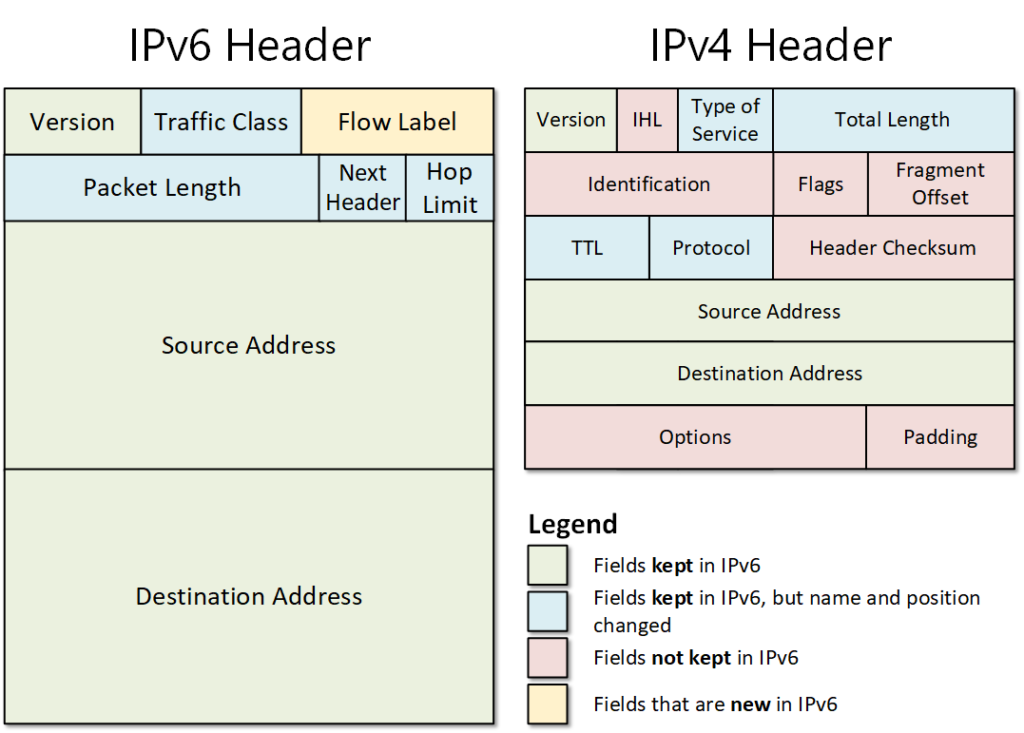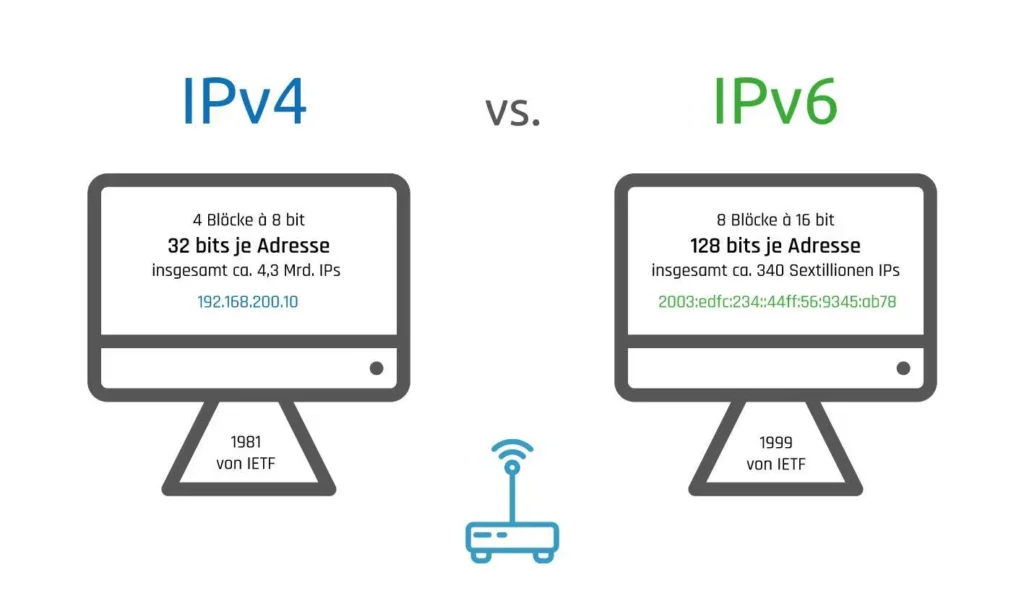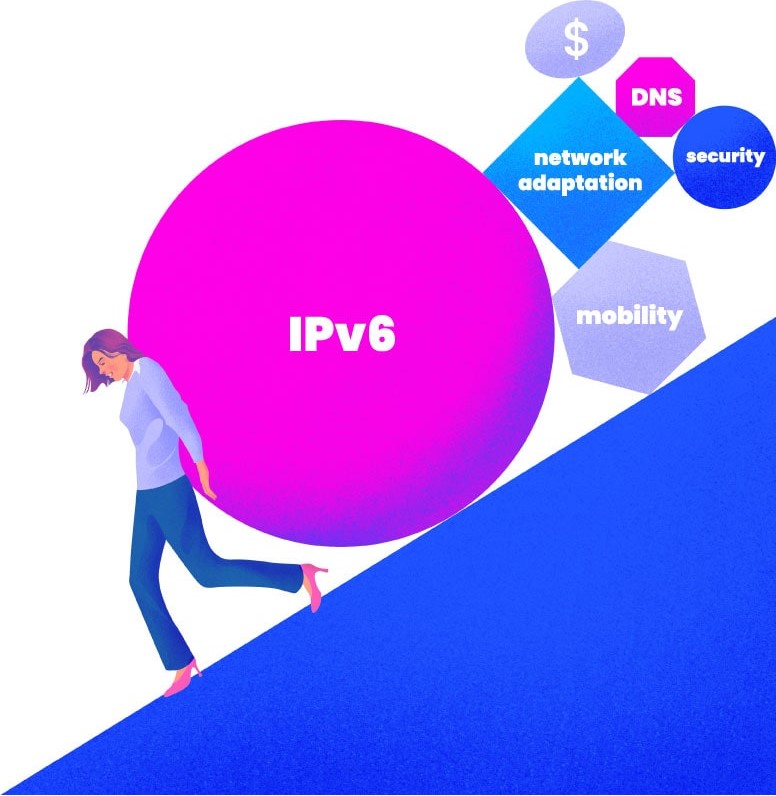The world of computer networking is constantly evolving, and two of the most relevant terms we need to understand are IPv4 and IPv6. These communication protocols are essential for devices to connect to the network, but they can often be confusing, especially for those just starting in the tech world. In this article, we will break down the key differences between IPv4 and IPv6, explaining how they work, their advantages, disadvantages, and why the switch to IPv6 is an imminent necessity.
What is IPv4?
IPv4 (Internet Protocol version 4) is the communication protocol that has been used for decades to assign unique IP addresses to each device connected to the network. This system operates hierarchically, where addresses are assigned in 32-bit numerical format, divided into four groups of numbers separated by periods (e.g., 192.168.0.1). Due to this structure, IPv4 allows a total of approximately 4.3 billion unique addresses.
Limitations of IPv4
Although IPv4 has been crucial in the growth of the Internet, it has several limitations that have become evident over time:
- Limited number of addresses: While 4.3 billion addresses might seem like a lot, in practice, they are not enough to meet the growing demand for connected devices. With the rise of mobile devices, IoT (Internet of Things), and the increase in digital globalization, IPv4 addresses began running out.
- Limited efficiency in address allocation: IPv4 uses a rather rigid address allocation system, which means some addresses end up being underutilized or unused. The concept of subnetting (subnets) helps organize these addresses, but it is not a perfect solution.
- Lack of security: IPv4 was not designed with security in mind. Although additional security measures can be implemented, the original protocol lacks robust authentication or integrated encryption.
What is IPv6?
IPv6 (Internet Protocol version 6) is the successor to IPv4, designed to solve the limitations mentioned above, and more. Developed in the late 1990s by the IETF (Internet Engineering Task Force), IPv6‘s main advantage is its ability to assign an almost unlimited number of IP addresses. This protocol uses 128-bit addresses, allowing for a massive expansion of the addressing capacity. Compared to the 4.3 billion addresses in IPv4, IPv6 can generate approximately 340 undecillion unique addresses, which is more than we will ever need.
Key Features of IPv6
- Longer and more flexible addresses: Unlike the 32-bit addresses in IPv4, IPv6 uses 128-bit addresses, allowing the creation of an almost infinite number of unique addresses. This ensures that every device in the world can have its own address without worrying about address depletion.
- Self-configuration: One of the most notable improvements of IPv6 is its ability to self-configure. Devices can automatically assign themselves an IPv6 address without needing a DHCP (Dynamic Host Configuration Protocol) server, simplifying the connection process.
- Better security: IPv6 was designed with security in mind, and it incorporates features such as authentication and encryption at the protocol level. This makes it a more secure option than IPv4, which requires additional tools to provide adequate security.
- Routing efficiency: By grouping and simplifying routing tables, IPv6 improves routing efficiency. This makes it easier to manage large networks and enhances data transmission speed.
How Do IPv4 and IPv6 Coexist?
Although IPv6 was designed to replace IPv4, the adoption process is not immediate. IPv4 remains the dominant protocol in most networks globally, and the transition to IPv6 has been gradual. However, as the depletion of IPv4 addresses becomes a more serious issue, the need to implement IPv6 grows more urgent.
Transition Methods Between IPv4 and IPv6
To ensure that networks are not disrupted during the transition, several techniques allow IPv4 and IPv6 to coexist smoothly. Here are some of the most common strategies:
- Dual Stack: In this approach, devices and routers operate with both IPv4 and IPv6. This allows networks to continue operating with IPv4 while gradually adapting to IPv6. Devices with both stacks enabled can communicate with other devices using either of the two protocols.
- Tunnels: IPv6 tunnels over IPv4 networks allow IPv6 packets to travel through an infrastructure that only supports IPv4. This solution is useful for interconnecting IPv6 networks with IPv4 networks without requiring the entire infrastructure to natively support IPv6.
- Network Address Translation (NAT64): This method allows IPv6 devices to communicate with IPv4 devices by converting addresses in the process. While not ideal, as it introduces complexity and may cause performance issues, it is one of the most viable solutions in networks still largely dependent on IPv4.
How Compatible is IPv6 with IPv4?
One of the most frequently asked questions when addressing the transition to IPv6 is whether devices and applications relying on IPv4 will continue to work on IPv6 networks. In general, IPv6 is not directly compatible with IPv4. This means, for example, that a device with only IPv4 cannot communicate directly with a device using only IPv6, and vice versa.

However, transition methods like Dual Stack allow both protocols to run in parallel, ensuring that networks can continue functioning without interruptions. Additionally, most modern operating systems and devices are IPv6-ready, making it easier to integrate networks gradually.
Advantages and Disadvantages of IPv4 and IPv6
When understanding the fundamental differences between IPv4 and IPv6, it’s crucial to evaluate the advantages and disadvantages of each. This not only helps us understand why IPv6 is the long-term option, but also why IPv4 remains so prevalent today.
Advantages of IPv4
- Wide compatibility: IPv4 is the most widely used internet protocol in the world. Most devices and networks are configured to work with IPv4, ensuring seamless compatibility with existing networks.
- Simplicity in configuration: Although IPv4 has some limitations in terms of address allocation, its configuration is quite simple, especially with the help of DHCP servers, which allow devices to automatically obtain an IP address.
- Cost reduction in existing infrastructures: Since IPv4 infrastructure is already globally implemented, companies can maintain their IPv4 networks without the need for significant investments in new hardware or software. This can result in lower short-term costs.
Disadvantages of IPv4
- IP address scarcity: As mentioned earlier, IPv4 has a limited number of addresses. This is leading to a shortage of available addresses, forcing organizations to use solutions like Network Address Translation (NAT) to share IP addresses between multiple devices, complicating management and security.
- Management complexity: While IPv4‘s initial configuration is simple, managing addresses becomes more complex as the network grows. Subnetting and NAT techniques can make IP address management more complex, especially for larger networks.
- Lack of integrated security features: IPv4 was not designed with security in mind. While additional measures can be implemented, it does not have integrated features to ensure secure communication. This can put data integrity at risk during transmission.
Advantages of IPv6
- Nearly infinite number of addresses: The greatest advantage of IPv6 is its ability to provide an almost unlimited number of IP addresses. This guarantees that each device can have its own unique address without worrying about address depletion in the future.
- Device self-configuration: With IPv6, devices can automatically configure themselves to obtain an address, simplifying network connection and reducing the need for a DHCP server. This feature is particularly useful in large networks or IoT applications.
- Improved security: IPv6 was designed with security as a priority. It includes features like IPsec (a set of protocols for network security) that allows for authentication and encryption of data in transit, making it much more secure than IPv4.
- Routing efficiency: Thanks to the simplification of routing tables and optimized address usage, IPv6 allows for more efficient routing, improving network performance.
Disadvantages of IPv6
- Limited compatibility with IPv4: While there are methods to make IPv4 and IPv6 coexist, IPv6 is not directly compatible with IPv4, meaning the transition will not be instant or simple. It requires time, effort, and resources to adapt existing networks.
- Greater complexity in initial configuration: Configuring IPv6 can be more complex, especially for networks that are not yet set up to handle 128-bit addresses. While devices can self-configure, the process of implementing IPv6 in an existing infrastructure may require considerable effort.
- Lack of support in some applications and devices: Although most modern devices are compatible with IPv6, some older applications and devices still only work with IPv4. This can create difficulties in fully adopting IPv6, especially in environments where legacy systems are used.
How to Prepare for the Transition from IPv4 to IPv6
The transition from IPv4 to IPv6 is not something that can be done overnight. It requires careful planning, especially for companies with large and complex infrastructures. In this section, we’ll detail some key steps to efficiently prepare and migrate to IPv6.

1. Assess the Current Network
The first step to a successful transition is to conduct a complete network infrastructure assessment. This includes reviewing all devices, applications, and services currently using IPv4 and determining how prepared they are to be compatible with IPv6.
- Devices and networking equipment: Ensure that routers, switches, and firewalls support IPv6. Many older devices may not be compatible with IPv6 or may require firmware updates.
- Operating systems and applications: Verify that all operating systems, servers, and applications in your network are compatible with IPv6. Modern systems like Windows 10/11, Linux, and macOS are typically natively compatible, but some older applications may need to be updated or replaced.
2. Obtain IPv6 Addresses
Once you’ve assessed your network and confirmed that the devices are compatible, the next step is to obtain an IPv6 address block. Unlike IPv4, IPv6 addresses are obtained through a global allocation process managed by an Internet Assigned Numbers Authority (IANA) or, in some cases, a regional Internet Registry (RIR).
- Address procurement: Contact your Internet Service Provider (ISP) or an RIR to obtain an IPv6 address block. This will allow you to assign unique addresses to devices within your network.
- Subnetting and planning: One of the advantages of IPv6 is the abundance of addresses. However, it is still important to properly plan out subnets to avoid disorganization when allocating addresses.
3. Configure IPv6 on the Network
With the IPv6 addresses in hand, the next step is to configure your network to support IPv6. Here are a few actions to take:
- Enable IPv6 on routers and switches: Ensure that all routers and switches used are configured to handle IPv6 traffic. This may require a change in settings or a software update for older devices.
- Configure IPv6 DNS servers: Domain Name Servers (DNS) must also be configured to support IPv6. Ensure that both forward and reverse DNS servers are correctly set up to resolve IPv6 addresses.
- Network segmentation: If you have multiple locations or branches, you’ll need to divide your network into subnets using IPv6 addresses. This process can be easier than with IPv4, thanks to the larger address pool.
4. Testing and Validation
Before completing a full migration, it’s important to test the new IPv6 configuration in a controlled environment. Here are some aspects to consider:
- Connectivity testing: Run tests to ensure that devices can communicate with each other properly using IPv6 addresses. Use tools like ping6 and traceroute6 to verify connectivity.
- Application compatibility check: Ensure that all critical applications function properly on an IPv6 network. This includes network applications, web servers, and any services that depend on IP addresses.
- Performance monitoring: Conduct performance tests to ensure that there are no significant impacts on speed or latency after implementing IPv6.
5. Staff Training
The transition to IPv6 may involve a learning curve for IT teams and network administrators. It’s important to provide proper training to ensure everyone understands how IPv6 works, how to configure it, and how to manage it.
- Technical training: Network administrators must learn how to configure and troubleshoot IPv6. This includes setup on routers, switches, and firewalls.
- Security training: The security of IPv6 is also critical. Although IPv6 offers more security options than IPv4, it’s still important to understand how to protect your network from potential IPv6 vulnerabilities.
The Future of the Internet: Why Adopting IPv6 is Crucial
The adoption of IPv6 is not just about a technical update; it has profound implications for the future of the Internet. As the number of connected devices continues to increase at a rapid pace, it’s essential to have infrastructure capable of handling this expansion. The shift to IPv6 will not only solve the IP address shortage but also lay the foundation for the Internet of the Future.
1. The Rise of the Internet of Things (IoT)
One of the main reasons IPv6 is crucial for the future of the Internet is the growth of the Internet of Things (IoT). Today, millions of devices like sensors, cameras, smart appliances, autonomous vehicles, and wearable devices are connected to the Internet. By 2030, it’s estimated that there will be over 50 billion IoT devices in use, each of which needs a unique IP address to function.
IPv4, with its limited number of addresses, cannot meet this demand. IPv6, with its almost unlimited address space, guarantees that all these devices will have unique, accessible addresses, ensuring the Internet of Things can continue to grow and evolve without hurdles.
2. More Efficient and Scalable Networks
IPv6 also improves the efficiency and scalability of networks. With IPv4, networks often rely on NAT (Network Address Translation) to share IP addresses between multiple devices, which adds complexity to the network and can affect performance and latency.
With IPv6, each device can have its own IP address, eliminating the need for NAT and simplifying routing. This not only improves data transmission speed but also makes network management easier by allowing for more direct and simple address allocation. In terms of scalability, IPv6 networks are far better equipped to handle an increasing number of devices and services without compromising performance.
3. Improvements in Internet Security
As online security threats become more sophisticated, security in IPv4 networks has fallen behind. Although security measures can be implemented in IPv4, these are generally add-ons and not integrated into the protocol. IPv6, on the other hand, was designed with security as a priority, making it a much more robust option for protecting data and online communications.
Some of the security features built into IPv6 include:
- IPsec: A set of protocols that provides encryption and authentication for data in transit, making connections more secure.
- Enhanced privacy: IPv6 introduces improvements in privacy, such as the ability to regularly change IP addresses to prevent online activity tracking.
- Fewer vulnerabilities: Due to its design, IPv6 is less susceptible to attacks such as port scanning or IP address spoofing, as these operations are more complex in IPv6.
4. New Opportunities for Innovation
The shift to IPv6 opens up a range of new opportunities for technological innovation. From the development of 5G networks to the creation of new applications and services, IPv6 is ready to support the future trends that will define the evolution of the Internet.
- 5G networks: 5G networks require network infrastructure that can handle a massive number of devices, and IPv6 is essential for making these networks scalable and efficient.
- Augmented Reality and Virtual Reality (AR/VR) applications: These applications require significant bandwidth and extremely low latency. IPv6 will enable the creation of faster and more reliable networks, essential for large-scale AR and VR applications.
- Smart Cities: Smart cities, which connect devices like traffic lights, surveillance cameras, and traffic sensors, rely on IPv6 to efficiently manage the growing number of connected devices.
5. Impact on SEO and User Experience
In addition to the technical benefits, the transition to IPv6 can also have an impact on SEO (search engine optimization) and user experience. As more websites and applications adopt IPv6, search engines like Google will start prioritizing IPv6-compatible sites.
- SEO and performance: Websites using IPv6 may experience faster load times due to the elimination of NAT and simplified routing. This can improve user experience and, in turn, the SEO of websites.
- Future compatibility: As IPv6 becomes more dominant, websites that are not compatible with this protocol could face connectivity issues, potentially affecting their online visibility and user satisfaction.

The Need to Adopt IPv6
The transition from IPv4 to IPv6 is crucial for ensuring the future of the Internet. While IPv4 has been the backbone of the global network for over three decades, its capacity is reaching its limit, and IPv6 offers the scale, security, and efficiency needed to support the ongoing growth of Internet infrastructure.
As technologies like the Internet of Things (IoT), 5G, and artificial intelligence continue to transform our digital lives, the shift to IPv6 is crucial to make the most of these innovations and ensure a more secure and efficient network.
Though the transition process can be challenging, it’s important to begin planning and adopting IPv6 to be ready for the future of global connectivity. It will not only allow you to overcome the IP address shortage but also open up new possibilities for technological innovation, enhanced security, and network efficiency.



